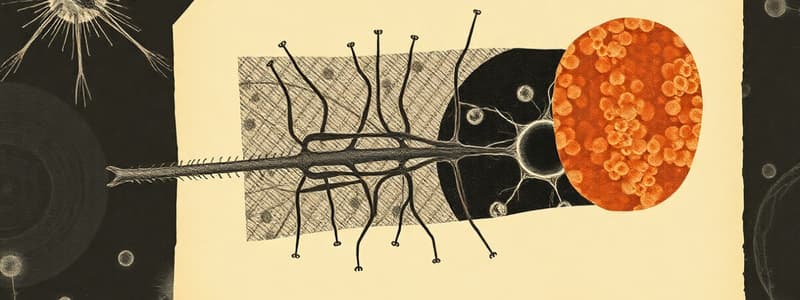Podcast
Questions and Answers
What is the primary function of the cytoskeleton in eukaryotic cells?
What is the primary function of the cytoskeleton in eukaryotic cells?
- To store genetic information
- To provide mechanical structure and support (correct)
- To produce ATP
- To synthesize proteins
Which of the following functions is NOT associated with the cytoskeleton?
Which of the following functions is NOT associated with the cytoskeleton?
- Guiding intracellular traffic
- Pulling chromosomes apart during mitosis
- Supporting the plasma membrane
- Storing nutrients (correct)
In what way does the cytoskeleton contribute to muscle cells?
In what way does the cytoskeleton contribute to muscle cells?
- By synthesizing muscle proteins
- By providing a site for nutrient storage
- By enabling them to contract (correct)
- By insulating the nerve connections
What role does the cytoskeleton play in nerve cells?
What role does the cytoskeleton play in nerve cells?
what are the spatial and mechanical functions found in an intricate system of filaments called?
what are the spatial and mechanical functions found in an intricate system of filaments called?
list the families of filaments and the proteins that make them up
list the families of filaments and the proteins that make them up
match each one with the appropriate description
match each one with the appropriate description
Describe the role of microtubules in a healthy cell.
Describe the role of microtubules in a healthy cell.
What are filopodia and lamellipodia, and what function do they serve?
What are filopodia and lamellipodia, and what function do they serve?
How do microtubules contribute to cell division?
How do microtubules contribute to cell division?
Explain the significance of stress fibers in cellular movement.
Explain the significance of stress fibers in cellular movement.
What happens to the cytoskeletal structures during cell division?
What happens to the cytoskeletal structures during cell division?
Discuss the concept of cell polarity and its importance.
Discuss the concept of cell polarity and its importance.
Flashcards
Cytoskeleton
Cytoskeleton
A network of protein filaments that provides structural support, enables movement, and helps with organization within a cell.
Microtubules
Microtubules
Long, thin protein fibers that help cells maintain their shape, resist tension, and move organelles.
Intermediate Filaments
Intermediate Filaments
Thicker protein fibers that provide support and help with cell movement.
Actin Filaments
Actin Filaments
Signup and view all the flashcards
Mitosis
Mitosis
Signup and view all the flashcards
Microtubule Star
Microtubule Star
Signup and view all the flashcards
Depolarization
Depolarization
Signup and view all the flashcards
Microtubule Organizing Center (MTOC)
Microtubule Organizing Center (MTOC)
Signup and view all the flashcards
Actin Filaments (Microfilaments)
Actin Filaments (Microfilaments)
Signup and view all the flashcards
Lamellipodium
Lamellipodium
Signup and view all the flashcards
Filopodia
Filopodia
Signup and view all the flashcards
Stress Fibers
Stress Fibers
Signup and view all the flashcards
Contractile Ring
Contractile Ring
Signup and view all the flashcards
Study Notes
Cell Function and Cytoskeleton
- Cells need to organize themselves and interact with their environment mechanically to function properly.
- They change shape and move to adjust to internal and external changes.
- Eukaryotic cells have a complex filamentous system, the cytoskeleton, that manages these spatial and mechanical needs. This system, including microtubules (MTs) and actin filaments (MFs), is dynamic and constantly changing to support diverse cell functions.
Cytoskeletal Functions
- Chromosome separation: Pulls chromosomes apart during mitosis.
- Intracellular transport: Guides and drives the movement of organelles within the cell.
- Plasma membrane support: Supports the fragile plasma membrane. MTs extend from the nucleus to the cell periphery.
- Stress resistance: Provides mechanical linkages enabling cells to handle pressure and strain. Stress fibers, bundled actin, can generate force for movement.
- Cellular movement: Enables sperm movement. Also allows fibroblasts and white blood cells to move across surfaces and is exemplified by cell migration through filopodia and lamellipodia.
- Cellular crawling: Allows fibroblasts and white blood cells to move across surfaces, enabling directional migration. Lamellipodia (a large sheet-like structure) and filopodia (elongated protrusions) are used. Microtubules (MTs) determine the cell's overall direction.
- Muscle contraction: Enables muscle cell contraction.
- Nerve development: Enables nerve cells to extend axons and dendrites.
- Cell division: Dynamic nature of MFs allows pinching of a cell into two separate cells using an actin contractile ring. Cell division also requires depolarization and reorganization of cytoskeletal structures (MTs and MFs). The mitotic spindle is comprised of MTs in these cells.
- Polarity: A non-symmetrical cell shape (polar structure) is critical for movement and other potential functions. Cellular polarity is related to cytoskeletal organization.
- Cellular organization: MTs form a star-like pattern emanating from the organizing center in the cell's middle
- Material transport: MTs serve as structural pathways for material transport within the cell.
- Cilia and Flagella: MTs are involved in cilia and flagella, both cell motility structures.
Studying That Suits You
Use AI to generate personalized quizzes and flashcards to suit your learning preferences.




